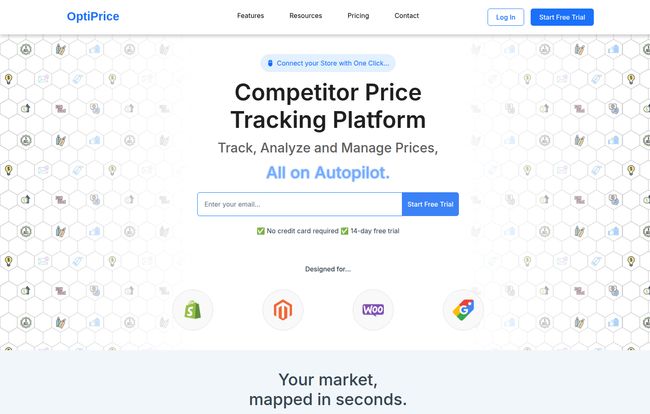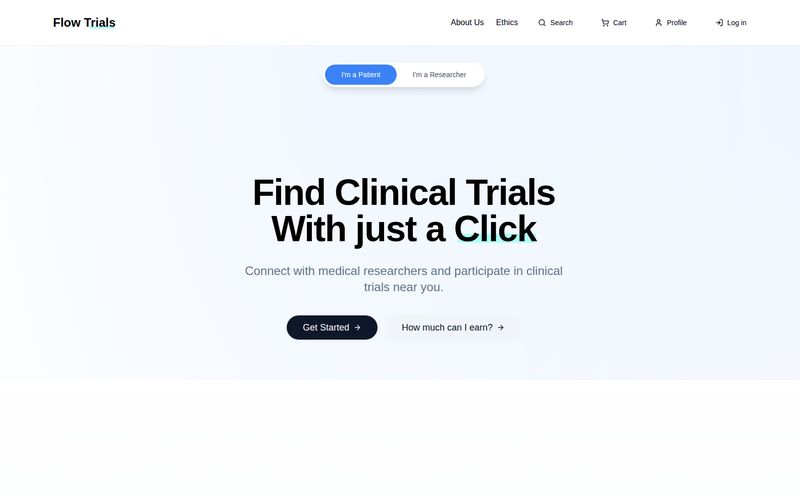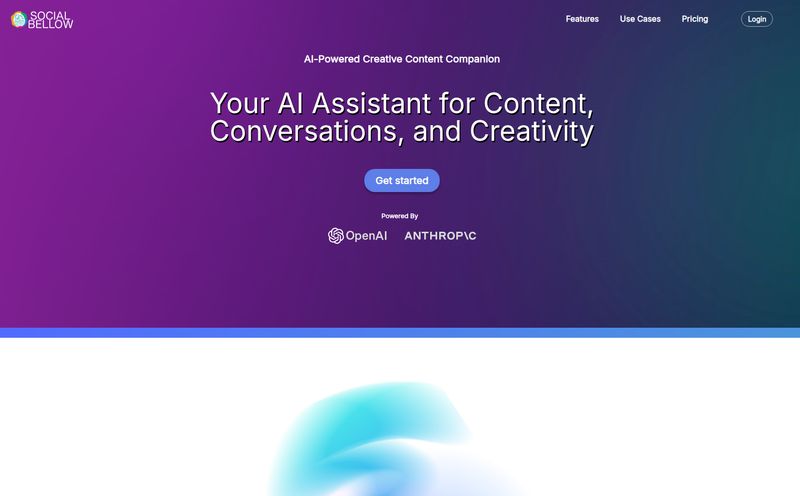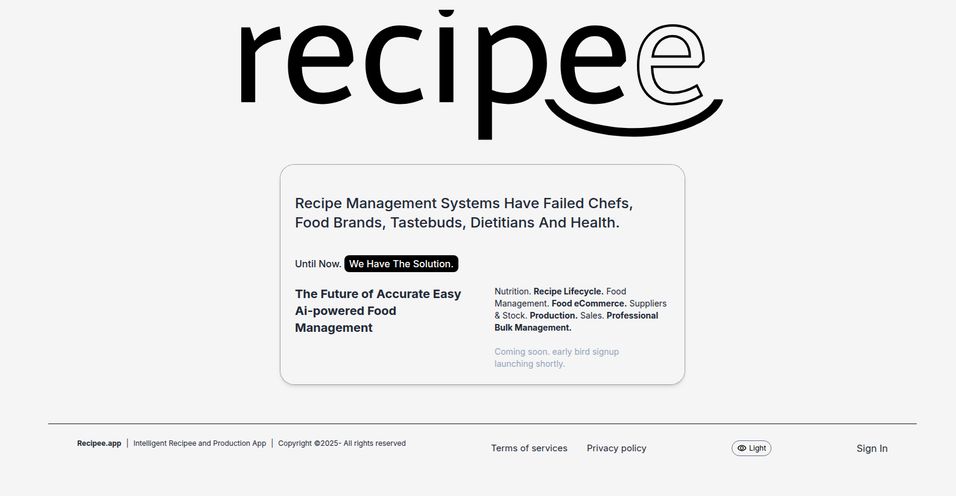Just you and me. If you've ever run an e-commerce store, you know the feeling. That little knot in your stomach when you wonder if your biggest competitor just dropped their prices. You spend your Tuesday morning—a morning you should be using for marketing or sourcing new products—manually typing URLs into your browser, squinting at product pages, and scribbling prices on a notepad. It’s a grind. A soul-sucking, time-devouring grind that can make you question your life choices.
Pricing. It’s the single most powerful lever you can pull for profitability, yet for most of us, it’s a total guessing game. For years, I've preached that traffic and conversions are king, but if your pricing strategy is a mess, you're just pouring water into a bucket full of holes. I’ve seen it happen to too many clients. So, when I come across a tool that promises to automate this whole painful process, my ears perk up. Enter OptiPrice, a competitor price tracking platform that claims to put your pricing on autopilot. But does it live up to the hype? I decided to take a look.
What Exactly is OptiPrice? (Beyond the Marketing Spiel)
Alright, let's cut through the jargon. At its core, OptiPrice is a spy. It’s like having a hawk-eyed accountant who only cares about what your rivals are charging, and they never sleep, never take a coffee break, and never get bored. It's an online suite designed specifically for retailers to automatically keep tabs on competitor prices and stock levels. The big idea is that instead of you doing the grunt work, this platform does it for you, then presents the data in a way that helps you make smarter, faster decisions. You track, you analyze, you react. Simple, right?
The whole system seems built around a pretty slick workflow: you connect your store (it plays nice with the big ones like Shopify and WooCommerce), tell it which products to watch, and then it uses Google Search to find who else is selling the same stuff. From there, it’s all automated monitoring.

Visit OptiPrice
My Favorite OptiPrice Features That Actually Matter
Any SaaS platform can throw a long list of features on its homepage. But after years in this business, you learn to spot the ones that are just fluff versus the ones that will genuinely change your workflow. Here's what stood out to me in OptiPrice.
Automated Competitor Discovery is a Game Changer
Honestly, this might be the biggest deal. Most older pricing tools required you to manually find and input every single competitor URL for every single product. Can you imagine? With a catalog of thousands of SKUs, that's just not feasible. OptiPrice's approach of using a Google Search integration to find your competitors is just... smart. It reflects how a real customer would find them, giving you a much more realistic view of the market you're actually competing in, not just the two or three big names you already know about.
Real-Time Alerts That Let You Sleep at Night
The real value of automation isn't just saving time; it's peace of mind. OptiPrice sends you notifications when things change. And I was really pleased to see it’s not just about price drops. You get alerted on price increases and, crucially, stock changes. Why is that so important? Because if your main competitor for a hot product suddenly runs out of stock, that's a golden opportunity for you. You might be able to nudge your price up a bit, or at the very least, you know you're about to capture all their potential sales. Without an alert, you could miss that window completely.
Pricing Analytics That Don't Require a PhD
Data is useless if you can't understand it. I’ve seen platforms that give you spreadsheets of raw data and expect you to be a data scientist. The dashboard screenshots for OptiPrice show clean line graphs and clear metrics. Seeing competitor price trends over time, visualized, is so much more powerful than a list of numbers. It helps you spot patterns. Is one competitor always dropping prices on Fridays? Does another always run out of stock by the end of the month? This is the kind of stuff that turns reactive pricing into a proactive strategy.
The API Access for Nerds Like Me
Okay, this one isn't for everyone, but its inclusion tells me that OptiPrice is a serious tool built for growth. An API (Application Programming Interface) is basically a way for different software to talk to each other. For a larger ecomerce business, this means you could potentially pull OptiPrice's data directly into your own internal dashboards, connect it to your inventory management system, or even build a dynamic pricing engine that adjusts your store's prices automatically based on the rules you set. It’s an advanced feature, but knowing it's there means the platform has a high ceiling.
Putting OptiPrice to the Test: The Good and The...Quirks
No tool is perfect. Let's be real. It's always a balance of what it does well versus its limitations. In my experience, transparency here is everything.
On the good side, the value proposition is incredibly strong. It automates a tedious and critical task, provides actionable data, and seems to be built with a modern, clean interface. Being GDPR/DPA compliant is also a huge checkmark that a lot of smaller toolmakers overlook. It shows they're thinking about professional, international businesses.
Now, for the quirks. The documentation mentions that products with multiple variants on the same URL might not be tracked properly. This is a common challenge for web scrapers. For instance, if you sell a T-shirt that comes in 10 colors, and the price changes only when you select the 'red' option but the URL doesn't change... that can be tricky for a bot to catch. My advice? Use that 14-day free trial to test this extensively with your most complex products. It might work perfectly, but it's something to verify for your specific setup.
How Much Does OptiPrice Cost? (The Big Question)
Ah, pricing. The moment of truth. OptiPrice uses a pretty straightforward tiered model based on the number of SKUs (Stock Keeping Units, or unique products) you want to track and how often you want it to check prices. I actually appreciate the transparency here. No “Contact us for a demo” nonsense on the main plans.
| Plan | Price | Key Features | My Take |
|---|---|---|---|
| Solopreneur | €24 /mo | 100 SKUs, 1 daily check, Price Notifications, API | Perfect for a small business or a side-hustle. If you have a small, curated inventory, this is a super affordable entry point. |
| Standard | €49 /mo | 2,000 SKUs, 2 daily checks, Stock Notifications, API | This looks like the sweet spot for most growing stores. The jump to 2,000 SKUs and adding stock notifications is massive value for the price. This is their 'Most Popular' for a reason. |
| Professional | €149 /mo | 10,000 SKUs, 4 daily checks, Stock Notifications, API | For the serious players who are scaling fast and have a larger catalog. More frequent price checks mean you're even quicker to react. |
| Custom | Contact Sales | Custom Solutions, Priority Support, Dedicated Account Manager | This is the "we mean business" enterprise plan. If you need this, you're likely a large operation and the dedicated support will be worth its weight in gold. |
And the best part? They offer a 14-day free trial with no credit card required. I can't stress this enough. It shows confidence in their product. They're letting you kick the tires and see the value for yourself before asking for a cent.
Who Should Use OptiPrice? And Who Can Pass?
So, is it for you? If you're an e-commerce store owner on a platform like Shopify or WooCommerce and you feel like you're constantly either losing sales to lower-priced competitors or leaving money on the table, then yes. You should absolutely give OptiPrice a try. If you believe that data, not guesswork, should drive your business decisions, this is a tool built for you.
Who should pass? Well, if you sell completely unique, one-of-a-kind art pieces with no direct competitors, a price tracker isn't going to do much for you. Or, I suppose, if you're a glutton for punishment and genuinely enjoy the thrill of manually checking 50 browser tabs every morning. For everyone else in the competitive world of online retail, it seems like a very compelling option.
Frequently Asked Questions About OptiPrice
How does OptiPrice monitor competitor prices?
It uses sophisticated automated technology, much like Google's own crawlers, to visit competitor websites and extract price and stock information in real-time. It's all done discreetly and efficiently behind the scenes.
Will my competitors know I'm tracking them?
No. The process is anonymous. OptiPrice acts as an independent third party, so your competitors won't know that you are the one monitoring their activity. It's your own secret market intelligence agent.
Is the platform compliant with GDPR / DPA?
Yes, their website explicitly states they are GDPR Ready. This is a crucial detail for any business operating in or selling to customers in Europe, and it's a good sign of their professionalism.
How does it handle different currencies?
While not detailed on the main page, competitor tracking tools like this typically either convert prices to a base currency you set, or allow you to view prices in their native currency. This would be a great question to ask their support during your trial period to see how it works best for your specific markets.
How difficult is the initial setup?
Based on the interface and description, it seems very straightforward. The process is designed to be a few clicks: connect your store, use the search tool to identify your key competitors for a product, and let the platform take over the monitoring. It's designed for busy store owners, not IT experts.
Can it track product variants like size or color?
This is the 'quirk' I mentioned. It's designed to track multiple variants, but if all those variants live on the exact same URL without changing it, there can be technical hurdles. The best way to know for sure is to test your specific products during the free trial.
My Final Verdict
Look, no tool is a magic wand that will instantly triple your revenue. Your success still depends on having great products, great marketing, and great customer service. But the right tools can act as force multipliers, and OptiPrice looks like a pretty powerful one. It takes one of the most stressful, time-consuming, and critical parts of running an online store and puts it on autopilot.
It frees up your time to work on your business instead of in your business. It replaces guesswork with data. For the monthly cost of a few nice dinners, it gives you a level of market intelligence that was once only available to massive corporations. In today's hyper-competitive market, that's not just a nice-to-have; it's a serious competitive advantage.
My advice? Don't just take my word for it. Give the 14-day free trial a spin. What do you have to lose, besides those hours spent manually checking prices?



